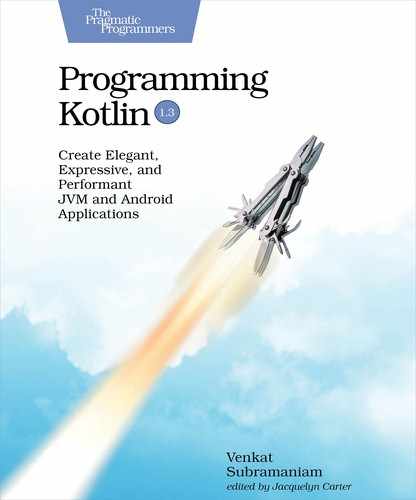Arrays of Objects and Primitives
The Array<T> class represents an array of values in Kotlin. Use arrays only when low-level optimization is desired; otherwise, use other data structures like List, which we’ll see later in this chapter.
The easiest way to create an array is using the arrayOf() top-level function. Once you create an array, you may access the elements using the index [] operator.
To create an array of Strings, for example, pass the desired values to the arrayOf() function:
| | val friends = arrayOf("Tintin", "Snowy", "Haddock", "Calculus") |
| | |
| | println(friends::class) //class kotlin.Array |
| | println(friends.javaClass) //class [Ljava.lang.String; |
| | println("${friends[0]} and ${friends[1]}") //Tintin and Snowy |
The friends variable holds a reference to the newly created array instance. The type of the object is Kotlin.Array, that is Array<T>, but the underlying real type, when run on the JVM, is a Java array of Strings. To get the values of the elements, the index operator [] is used and that, in turn, will invoke the get() method of Array<T>. When used on the left-hand side, the index operator [] will invoke the set() method of Array<T>.
The previous code created an array of Strings; to create an array of integers we may be tempted to use the same method, as in this example:
| | val numbers = arrayOf(1, 2, 3) |
| | println(numbers::class) //class kotlin.Array |
| | println(numbers.javaClass) //class [Ljava.lang.Integer; |
That works, but it may not be a smart way. When numbers were passed to arrayOf(), the instance created was Array<T>, as expected, but internally it is an array of boxed Integer types. That overhead is unnecessary when working with primitive types.
The specialized functions like intArrayOf() are better alternatives to create specialized arrays that don’t have the boxing overhead. To create an array of ints instead of an array of Integers, change the previous code to the following:
| | val numbers = intArrayOf(1, 2, 3) |
| | println(numbers::class) //class kotlin.IntArray |
| | println(numbers.javaClass) //class [I |
The same operations that are available on Array<T> are available on the specialized classes like IntArray as well. So even though they are different types, you may use them as if they were the same type.
In addition to using the index operator [] to get and set values, you may determine the size of the array using the size property. Also, you may use one of many functions on Array[18] to conveniently work with arrays. Let’s exercise the size property and one useful method—average—on the array we just created:
| | println(numbers.size) //3 |
| | println(numbers.average()) //2.0 |
Explore the Kotlin.Array<T> class to learn about the different methods you may use on an array of objects and primitives.
Instead of hard-coding the values when creating an array, you may also compute the values if you like. For example, in the code that follows we’re computing the square of values from 1 to 5 into an array and then totaling the values in the array:
| | println(Array(5) { i -> (i + 1) * (i + 1) }.sum()) //55 |
The Array constructor takes two parameters, the size of the array and a function that takes the index, starting with 0, and returns the value to be placed at that index. The syntax for this function in the example uses a lambda expression, which we’ll explore further in Chapter 10, Functional Programming with Lambdas.
If you want an ordered collection of elements with flexible size, then you may want to consider a list instead of an array. Also, unlike an array, which is mutable, list comes in both mutable and immutable flavors.
